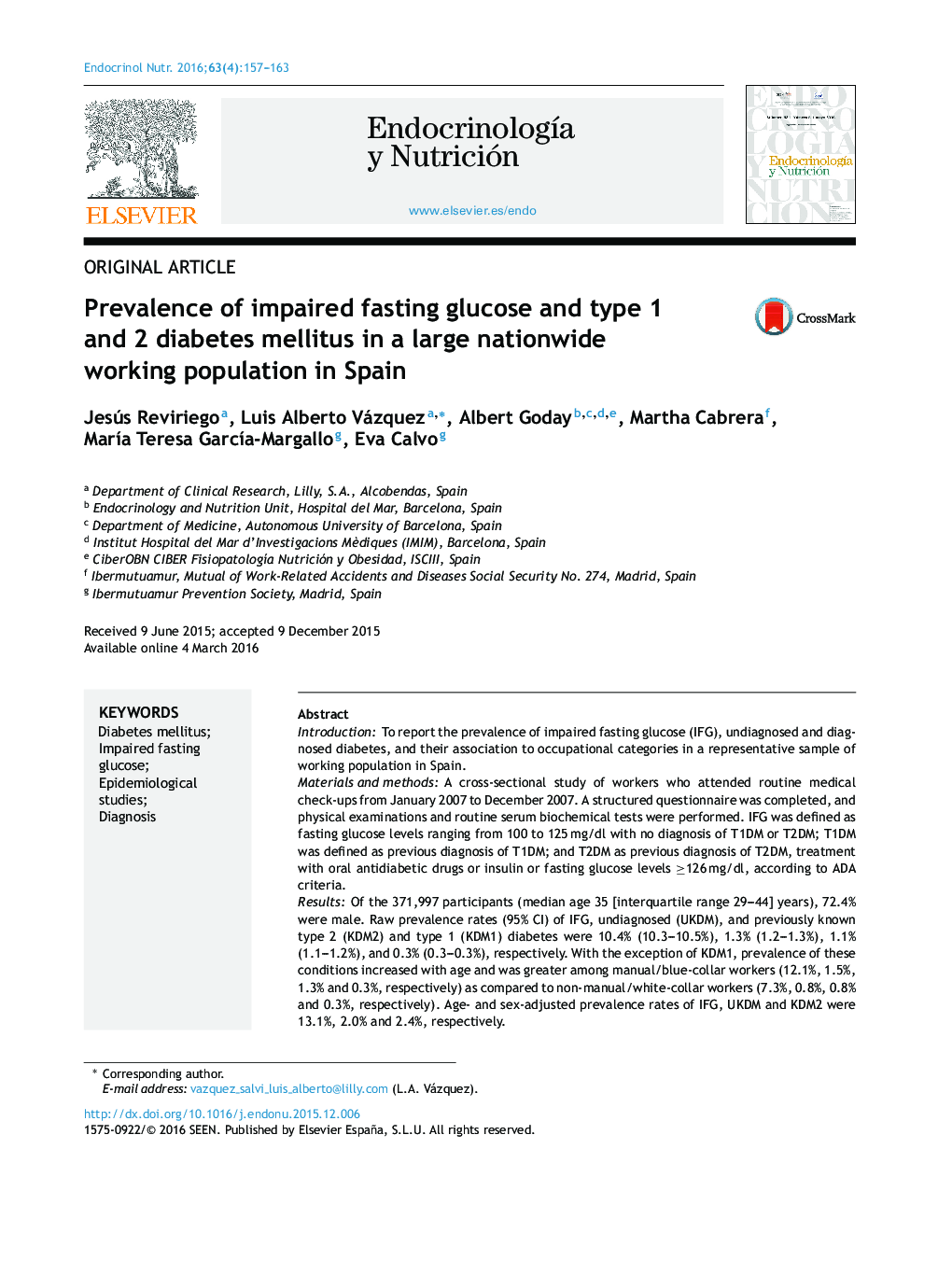| کد مقاله | کد نشریه | سال انتشار | مقاله انگلیسی | نسخه تمام متن |
|---|---|---|---|---|
| 2773284 | 1152126 | 2016 | 7 صفحه PDF | دانلود رایگان |
IntroductionTo report the prevalence of impaired fasting glucose (IFG), undiagnosed and diagnosed diabetes, and their association to occupational categories in a representative sample of working population in Spain.Materials and methodsA cross-sectional study of workers who attended routine medical check-ups from January 2007 to December 2007. A structured questionnaire was completed, and physical examinations and routine serum biochemical tests were performed. IFG was defined as fasting glucose levels ranging from 100 to 125 mg/dl with no diagnosis of T1DM or T2DM; T1DM was defined as previous diagnosis of T1DM; and T2DM as previous diagnosis of T2DM, treatment with oral antidiabetic drugs or insulin or fasting glucose levels ≥126 mg/dl, according to ADA criteria.ResultsOf the 371,997 participants (median age 35 [interquartile range 29–44] years), 72.4% were male. Raw prevalence rates (95% CI) of IFG, undiagnosed (UKDM), and previously known type 2 (KDM2) and type 1 (KDM1) diabetes were 10.4% (10.3–10.5%), 1.3% (1.2–1.3%), 1.1% (1.1–1.2%), and 0.3% (0.3–0.3%), respectively. With the exception of KDM1, prevalence of these conditions increased with age and was greater among manual/blue-collar workers (12.1%, 1.5%, 1.3% and 0.3%, respectively) as compared to non-manual/white-collar workers (7.3%, 0.8%, 0.8% and 0.3%, respectively). Age- and sex-adjusted prevalence rates of IFG, UKDM and KDM2 were 13.1%, 2.0% and 2.4%, respectively.DiscussionIn this sample of Spanish working population, impaired glycemic profiles were common. Prevalence rates of IFG and T2DM were high among blue-collar workers (except for T1DM). These data emphasize the need for earlier structured preventive schemes.
ResumenObjetivoDescribir la prevalencia de glucemia alterada en ayunas (GAA), diabetes no diagnosticada y diabetes, y su asociación con categorías profesionales en una muestra representativa de población trabajadora en España.Material y métodosEstudio transversal en trabajadores que realizaron revisión médica entre enero y diciembre de 2007. Se realizó exploración física, análisis de sangre y se utilizó un cuestionario estructurado. Se definió GAA como glucosa en ayunas 100-125 mg/dl sin diagnóstico de diabetes tipo 1 (DM1) o diabetes tipo 2 (DM2); DM1 como diagnóstico previo de DM1; y DM2, según criterios ADA, como diagnóstico previo de DM2, tratamiento con antidiabéticos orales o insulina, glucosa en ayunas ≥ 126 mg/dl.ResultadosDe los 371.997 participantes (mediana de edad 35 [rango intercuartílico 29-44] años), el 72,4% eran varones. La prevalencia (IC 95%) de GAA, diabetes no diagnosticada y DM2 y DM1 conocidas previamente fue del 10,4% (10,3-10,5%); 1,3% (1,2-1,3%); 1,1% (1,1-1,2%) y 0,3% (0,3-0,3%), respectivamente. Excepto para DM1, la prevalencia aumentó con la edad y fue mayor en trabajadores manuales (12,1; 1,5; 1,3; y 0,3% respectivamente) que en trabajadores no manuales (7,3; 0,8; 0,8; y 0,3% respectivamente). La prevalencia de GAA, diabetes no diagnosticada y DM2 ajustada por edad y sexo fue del 13,1, 2,0 y 2,4% respectivamente.ConclusionesEn esta muestra de población trabajadora en España, las alteraciones del perfil glucémico fueron frecuentes. En trabajadores manuales (excepto en DM1) las prevalencias de GAA y DM2 fueron mayores. Estos datos resaltan la necesidad de programas preventivos de intervención más temprana.
Journal: Endocrinología y Nutrición - Volume 63, Issue 4, April 2016, Pages 157–163
